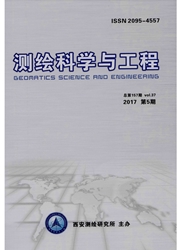

 中文摘要:
中文摘要:
随着在轨失效航天器数量的不断增加,对这类空间非合作目标的在轨服务需求变得日益迫切。由于在轨的非合作目标飞行器上无法布置合作标志器,只有通过提取非合作目标上的角点对其进行跟踪,求其目标的相对位置与姿态变化。其中,Harris角点检测算法是经典的方法,但其检测性能依赖于高斯窗口的大小以及阈值的选取,本文对此做出改进。首先设置较低的闯值,检测出图像中的疑似角点;其次构造一个新的模板,通过内外两个菱形上的像素点评估中心像素邻域的灰度变化,用构建的新模板遍历每一个疑似角点,去除伪角点,得到最终检测结果。算法在计算内外两个菱形上像素的灰度变化,充分考虑了角点在局部区域灰度变化明显的特征,其不涉及微分运算,所以具有较好的鲁棒性。通过实验验证了新算法对空间非合作目标具备良好的检测性能。
 英文摘要:
英文摘要:
With the increase of broken spacecraft in orbit, the demand for servicing this kind of non-cooperative target becomes increasingly urgent. Since the cooperation marker can not be deployed to non-cooperative target spacecraft, the relative position and attitude of the target can only be estimated by extracting and tracking the feature points of non-cooperative target. Harris corner detection is a classical algorithm, but the detection result is closely related to the selection of Gaussian window size and threshold value. In order to solve this problem, an improved algorithm is proposed. Firstly, a lower threshold is set to detect the suspected comers in image, and then a new template is constructed to evaluate the gray change of center pixel adjacent areas with the pixels in two rhombuses. At last, the fake comers are eliminated by evaluating every suspected corner with the new template and the final results are obtained. The proposed algorithm is robust, because the distinctive features of comers in gray change of local areas are fully considered in calculating the gray change of pixels in rhombus and the whole process is not invloved with differential operation. The experiment results validates the effectiveness and feasibility of the proposed method in dealing with non-cooperative target in space.
 同期刊论文项目
同期刊论文项目
 同项目期刊论文
同项目期刊论文
 期刊信息
期刊信息
